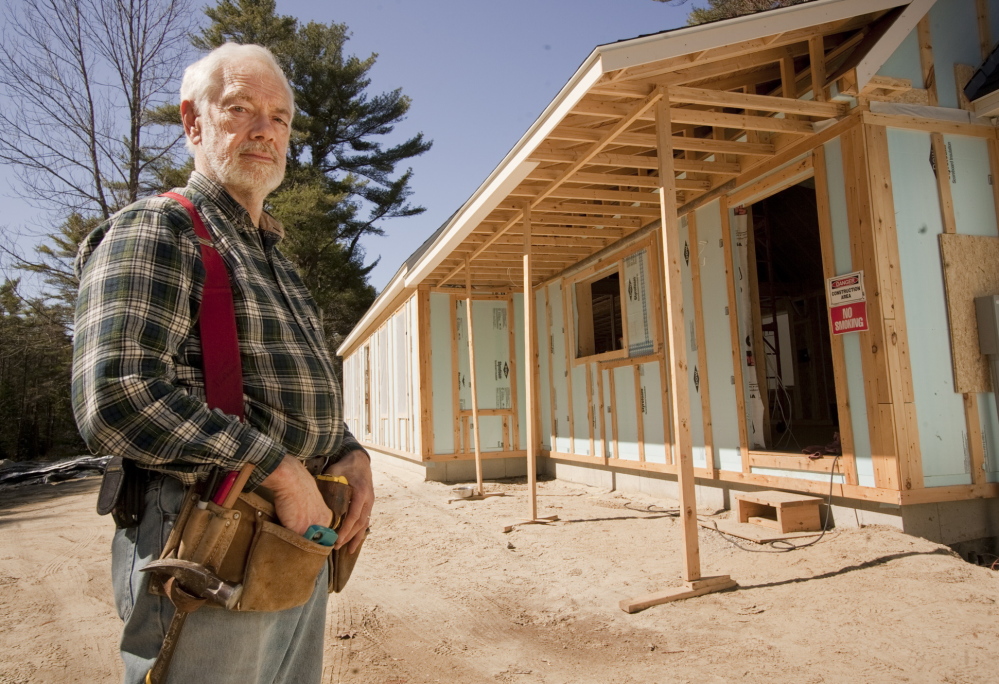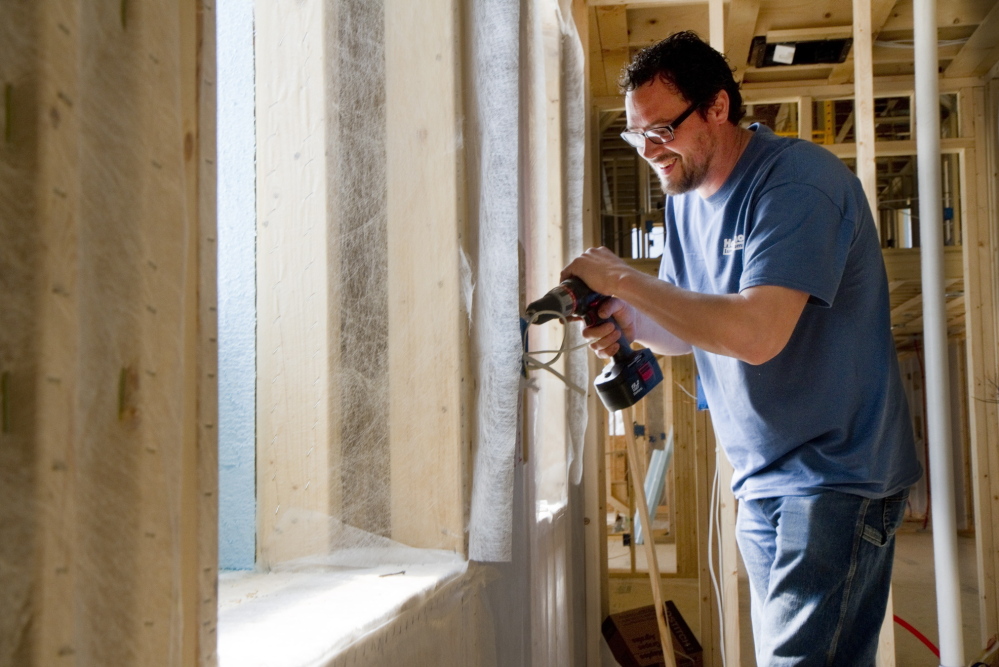Robert Howe’s reaction to the oil embargo of the mid-1970s was to build his own thermal shutters for the windows of his home.
A lifelong advocate of energy conservation, Howe, 69, is now pouring his passion for energy efficiency into a net-zero energy home he and his wife are building in Brunswick. The 2,400-square-foot home will integrate solar panels, heat pumps and insulation techniques to create a home that produces as much as energy as it consumes.
“I think it might still be called a niche market, but I definitely think it’s a growing one,” said Howe, who runs his own lobbying firm, Howe, Cahill & Co., and is the CEO of the Maine Association of Building Efficiency Professionals.
He’s not alone in that observation. Although there is no organization or state agency that tracks the number of net-zero energy homes built in Maine annually, there is growing anecdotal evidence that net-zero energy homes are on the rise. Escalating costs for fossil fuel heat, the recent relentless winter and the falling costs of renewable energy technology are spurring interest.
“Year over year we’re seeing steady growth in new construction of net-zero homes,” said Phil Coupe, co-founder of Revision Energy in Portland. “And most of those projects come to our attention because [they include] solar electricity into the construction plans.”
Coupe estimates that Revision Energy installed solar panels on about 30 net-zero energy home projects last year, and expects that number to grow by 50 percent this year.
Parlin Meyer, director of BrightBuilt Home, which specializes in pre-designed modular net-zero energy homes, said she receives as many as 20 inquiries a week from people interested in building net-zero energy homes. BrightBuilt Home is a subsidiary of Kaplan Thompson Architects in Portland, and partners with Keiser Homes for the buildings.
“The modular and pre-designed template makes it more accessible to the average home buyer,” Meyer says.
Since BrightBuilt Home launched in June 2013, it’s working on 12 new homes throughout New England, including four in Maine that will be built this year, according to Meyer.
While there are no hard data on the construction of net-zero energy homes, there are data that show an increase in the broader area of energy-efficient homebuilding. The share of the single-family home construction market dedicated to green construction grew from 8 percent in 2008 to 17 percent in 2011, according to a report published last year by McGraw-Hill Construction. The report estimates that green home construction – defined as environmentally responsible and energy-efficient, but not necessarily net-zero – will grow its market share to between 29 percent and 38 percent by 2016. The numbers suggest that net-zero energy homes, as a subset of the green homebuilding market, are moving toward wider adoption.
The federal government has committed to embracing net-zero energy construction. President Obama issued an executive order in 2009 that calls for all new federal buildings to be designed as net-zero by 2030.
Homes built today without energy-efficient designs will be obsolete within the decade, says Phil Kaplan, a founder of Kaplan Thompson Architects, which has built 40 net-zero energy homes since it was founded in 2004, though not all in Maine.
“Now as the economy recovers in Maine we’re seeing people understand this as a better investment,” Kaplan says. “The thing that is inevitable is codes will change. Homes that are better insulated and more airtight are going to be the norm. There’s no doubt we’re going in that direction.”
Tom Fullam, a home builder in Vassalboro and advocate of net-zero energy homes, began offering classes several years ago in this type of home construction. Four years ago, he estimates he taught seven students a year. This year, he’ll teach at least 35 students, including homeowners and contractors, he says.
“Basic net-zero energy ready homes can be built for the same amount as standard code-built homes by eliminating the need for a standard boiler. With the addition of renewable energy features consumers can end up with an all-electric home with annual utility costs under $120,” Fullam writes in an email. “I consider not building this way voluntary ignorance.”
‘The future of building’
Howe’s home is expected to cost about $350,000, and his contractor estimates the price is about 20 percent to 25 percent higher than if it had been built using conventional methods.
“I’m excited because this is the future of building,” Dan Swan, owner of Quality Building Services, said on a recent morning while standing in the shell of Howe’s home.
Swan was a neophyte in building net-zero energy homes, but became a convert. After Howe approached him about the job, Swan delved into the details of what it takes to build a net-energy zero home – namely, techniques that stress efficiencies gained by added insulation and smart design. For example, Swan built Howe’s home with double-stud walls. Rather than having 2-by-4s separate vertical strips of insulation, the walls are framed wider and studs alternate in a zigzag pattern through which insulation snakes uninterrupted, avoiding what’s called a “thermal bridge” where energy leaks out. Coupled with other elements, such as energy-efficient windows, the house will be so airtight that a special ventilation system will be used to circulate the air.
“The only way he’s going to lose energy in this house is when he opens the door,” says Peter Swan, Dan’s brother and co-worker.
Dan Swan has been building homes for years, but only launched his own business a year and a half ago. He has used the construction of Howe’s home as a chance to develop a system that will make each new net-zero energy home he constructs a little bit easier.
“This is a chance to separate ourselves from the slam-bam-throw-up-the-house builders who don’t care about all this stuff,” Swan says. When adoption of net-zero energy home construction reaches the mainstream, which he’s confident it will, he’ll be in a better position than most contractors to take advantage, he says.
But mainstream isn’t where the industry is just yet.
In 2012, two residential developers in York County announced plans for a subdivision in Wells that would consist solely of net-zero energy homes. However, the development, called Brackett Estates, didn’t go anywhere. While the model home was built and sold, the rest of the subdivision did not materialize. Craig Briggs of CB Builders and Jesse Ware of JP Ware Design, the two builders behind the project, did not return phone calls seeking comment. However, Kaplan, whose firm designed the model home, said the failure of that project should not be a reflection of the demand for these types of homes in Maine. He said that project was like “fitting a square peg in a round hole.”
“It’s a wonderful house and we’ve got a lot of work from it, but that particular location in that particular demographic was not a great fit,” Kaplan says.
Advocates acknowledge that there’s a perception in the market that net-zero energy homes are only for the affluent. But the payback times for energy-efficient systems is shrinking.
For an average home the size of Howe’s, Coupe estimates the solar array system could cost between $9,000 and $13,000. And incentives, such as 30 percent federal income tax credit, exist to reduce the figure.
According to Coupe, a homeowner who invests in a solar array on his roof will receive an 8 percent to 9 percent return on that investment. He noted the price has fallen 75 percent over the past eight years.
“When you think about all the things people can do – build a deck, build a car garage, finish the basement – … none of those investments will ever pay you back financially, but if you put a solar array onto your roof, you’re going to take free fuel from the sky, turn it into a valuable commodity in kilowatt-hours and those will be free. So solar electric arrays will be the sole investment they can make that will put every dime back in their pocket,” Coupe says.
If Howe’s home was built to traditional standards with an oil furnace, he could expect to pay at least $3,000 a year in oil costs. He hasn’t done all the calculations to figure the payback, but said he doesn’t think it will take very long. Adding to the ROI equation will be the installation of heat pumps.
Ten years ago, heat pumps were primarily found in the South and used for cooling, said Coupe.
“Now the technology has evolved to the point where you can get air conditioning in the summer at twice the efficiency of the best window unit on the market, but you can also get home heating throughout the Maine winter, down to minus 13 degrees Fahrenheit,” he said. “When you marry solar electricity with a hyperefficient technology like an air-source heat pump, the result is heating your home at the equivalent of 89 cents a gallon for oil. It’s phenomenal.”
Efficiency Maine offers $500 rebates for heat pumps, which can cost several thousand dollars, according to Coupe. Howe plans to install an array of solar photo-voltaic panels on his south-facing roof that will power his heat pump. He also expects to have a solar hot water system.
While the new house in Brunswick will be his and his wife’s first net-zero energy home, Howe acknowledges it’s not just a financial decision or a matter of principle. There are bragging rights that go along with saying you have a net-zero energy home.
“I think it’s good for my pocketbook, good for the planet and I’m an old frugal Mainer,” he says. “I don’t want to heat the outdoors with my money.”
Whit Richardson can be reached at 791-6463 or at:
Twitter: whit_richardson
Send questions/comments to the editors.




Comments are no longer available on this story